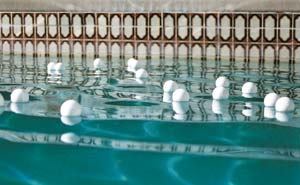Dirt, leaves and algae in a pool?s corners will create persistent problems. Eliminating these ?dead spots? requires a properly functioning circulation system that redistributes debris between the strainer and the filter.
A pool?s shape, piping, plumbing, pump performance, turnover rates and location of inlet fittings also contribute to adequate flow. In some cases, even a well-engineered flow design may not always work. But adjustments can be made to fix these problems.
To observe a pool?s circulation, try the ping-pong ball test. This involves tossing at least a dozen ping-pong balls into the pool and watching where they travel. The balls should travel in a clockwise pattern and eventually end up in the skimmer basket.
To test the skimmer?s draw, drop a single ball just front of the skimmer basket. The ball should move quickly toward the skimmer and over the weir. If the draw is weak, try readjusting the suction valves (main drain and skimmer); it should create better circulation flow.
You can also introduce a chemical called sodium fluorescein, or crystal violet, into the skimmer to tell whether the pool has proper circulation. Crystal violet is bright purple, but it won?t show up when chlorine is present.
To conduct the test, first eliminate any chlorine residual by adding sodium thiosulfate at a dosage of 2.6 ounces per 10,000 gallons of water. This should lower the chlorine residual to a reading of 0 ppm (per the National Swimming Pool Foundation?s Certified Pool/Spa Operator Handbook).
To prepare the dye, you must mix the powder in a bucket prior to pouring it into the skimmer. You need to be precise because the solution requires very little powder (generally 25 grams per 2 gallons of water). As soon as test readings show no chlorine, add the crystal violet as directed.
Once the crystal violet mixture passes through the filtration system, it will come out of the inlets and begin to cover the pool.
It may take several hours to analyze the entire pool through this process. But it will allow you to pinpoint the areas where the dye does not reach. To eliminate these dead spots, simply adjust the inlets until there is complete circulation coverage.
Once the test is complete, add chlorine to the pool. This will bleach out the purple tint.
Remember, a few twists and turns of the wall fitting can direct clean, filtered water in a smooth transition.
I firmly believe you should never see a rippling effect from the inlets on the pool?s surface.
When the inlets? eyeballs are pointed upward, the filtered water simply flows to the surface, where it?s captured in the skimmer soon thereafter. As a result, the inlet water is unable to dilute the unfiltered water, and additional dead spots are invited into the pool.
You want to direct the inlets so they allow a circular path of flow toward the skimmer(s). By positioning the eyeballs downward at 45 degrees, it allows the filtered water to mix with the deeper water. This creates dilution and stirs up any debris on the pool floor. The resulting flow sets debris on a path toward the skimmer and/or main drain.
Pool professionals must always be mindful of a circulation system?s hydraulics. Simply increasing the horsepower of a pump to boost flow through the returns without considering the piping may create cavitation.
One trick of the trade involves changing the eyeball size. Increasing or reducing the eyeballs may help redirect the flow and force more water toward areas where debris tends to accumulate.



